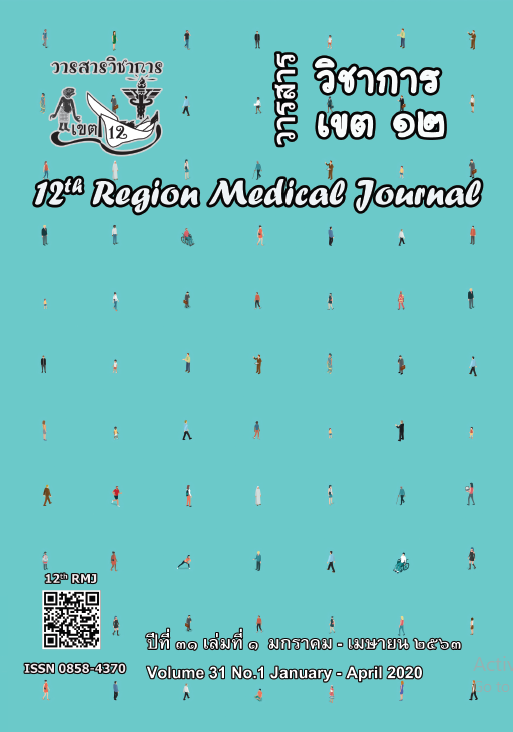ประสิทธิผลของการเข้าร่วมค่ายเบาหวานต่อค่าน้ำตาลสะสม ในผู้ป่วยเด็กและวัยรุ่นที่ป่วยด้วยโรคเบาหวาน ชนิดที่ 1
Main Article Content
บทคัดย่อ
บทนำ: ผู้ป่วยเด็กและวัยรุ่นโรคเบาหวานชนิดที่ 1 ส่วนใหญ่ไม่สามารถควบคุมระดับน้ำตาลในเลือดให้อยู่ในเกณฑ์ที่ยอมรับได้ การจัดค่ายเบาหวานเพื่อส่งเสริมการเรียนรู้เรื่องทักษะการดูแลรักษาตนเอง เชื่อว่าสามารถควบคุมระดับน้ำตาลในเลือดให้อยู่ในเกณฑ์ปกติได้
วัตถุประสงค์: เพื่อประเมินประสิทธิผลของการเข้าร่วมค่ายเบาหวานโดยเปรียบเทียบค่าเฉลี่ยระดับน้ำตาลสะสมระหว่างก่อนและหลังเข้าร่วมค่ายที่ 3 เดือน และ 6 เดือน
วิธีการศึกษา: การศึกษาจากเหตุไปผลแบบไปข้างหน้าในผู้ป่วยเบาหวานชนิดที่ 1 อายุ 2-18 ปี ที่เข้าร่วมค่ายเบาหวานตั้งแต่ปี พ.ศ. 2550 - 2561 มีการเก็บข้อมูลจากเวชระเบียน ในส่วนข้อมูลพื้นฐาน ได้แก่ เพศ อายุปัจจุบัน อายุที่เริ่มเป็นระยะเวลาที่เป็นโรค การเข้าสู่วัยรุ่น ชนิดของอินซูลินที่ใช้ เป็นต้น เปรียบเทียบค่าเฉลี่ยระดับน้ำตาลสะสม (HbA1c) ระหว่างก่อนและหลังเข้าร่วมค่ายที่ 3 เดือน และ 6 เดือน โดยใช้สถิติ paired t test หรือ Wilcoxon signed rank test
ผลการศึกษา: ผู้ป่วยเบาหวานชนิดที่ 1 เข้าร่วมค่ายเบาหวานทั้งหมด 53 ราย อายุเฉลี่ย 11.57 ± 4.15 ปี ระยะเวลาการเป็นโรคเบาหวานเฉลี่ย 3.1 ± 2.39 ปี ค่าเฉลี่ยระดับน้ำตาลสะสม (HbA1c) ก่อนเข้าร่วมค่ายเบาหวาน 10.48 % ±2.82 ค่าเฉลี่ย HbA1c หลัง เข้าร่วมค่าย 3 เดือนและ 6 เดือน ได้แก่ 10.23 % ± 2.79 และ 10.57 % ± 2.96ตามลำดับ พบว่า จำนวนคนที่ระดับ HbA1c ลดลง 30 ราย เพิ่มขึ้น 21 ราย หลังจากเข้าร่วมค่ายเบาหวาน 3 เดือน ค่าเฉลี่ย HbA1c หลังเข้าร่วมค่ายเบาหวาน 3 เดือนลดลงเมื่อเปรียบเทียบกับก่อนเข้าร่วมค่าย แต่ไม่พบการเปลี่ยนแปลงที่มีนัยสำคัญทางสถิติของค่าเฉลี่ยระดับ HbA1c ระหว่างก่อนและหลังเข้าร่วมค่ายที่ 3 เดือน (mean difference 0.24, p-value 0.36) และ 6 เดือน (mean difference -0.09, p-value 0.49)
สรุป: ไม่มีการเปลี่ยนแปลงของระดับน้ำตาลสะสมหลังการเข้าร่วมค่าย 3 และ 6 เดือน
Article Details

อนุญาตภายใต้เงื่อนไข Creative Commons Attribution-NonCommercial-NoDerivatives 4.0 International License.
เอกสารอ้างอิง
Craig ME, Jefferies C, Dabelea D, Balde N, Seth A, Donaghue KC. ISPAD Clinical Practice Consensus Guidelines 2014. Definition, epidemiology, and classification of diabetes in children and adolescents. Pediatr Diabetes. 2014;15(Suppl 20):4-17.
Rewers MJ, Pillay K, de Beaufort C, Craig ME, Hanas R, Acerini CL,et al. ISPAD Clinical Practice Consensus Guidelines 2014. Assessment and monitoring of glycemic control in children and adolescents with diabetes. Pediatr Diabetes. 2014;15(Suppl 20):102-14.
Wood JR, Miller KM, Maahs DM, Beck RW, Dimeglio LA, Libman IM, et al. Most youth with type 1 diabetes in the T1D exchange clinic registry do not meet American Diabetes Association or International Society for Pediatric and Adolescent Diabetes clinical guidelines. Diabetes Care. 2013;36:2035-7
DiMeglio LA, Acerini CL, Codner E, Craig ME, Hofer SE, Pillay K, et al. ISPAD Clinical Practice Consensus Guidelines 2018. Glycemic control targets and glucose monitoring for children, adolescents, and young adults with diabetes. Pediatr Diabetes. 2018;19(Suppl 27):105-14.
Lange K, Swift P, Pankowska E, Danne T. ISPAD Clinical Practice Consensus Guideline 2014. Diabetes education in children and adolescents. Pediatr Diabetes. 2014;15(Suppl 20):77-85.
Dumrisilp T, Supornsilchai V, Wacharasindhu S, Aroonparkmongkol S, Sahakitrungruang T. Factors associated with glycemic control in children and adolescents with type 1 diabetes mellitus at a tertiary-care center in Thailand: a retrospective observation study. Asian Biomed (Res Rev News). 2017;11(6):443-50.
American Diabetes Association: The Journey and the Dream. Alexandria, VA, American Diabetes Association, 1990
American Diabetes Association. Diabetes care at diabetes camps. Diabetes Care. 2004;27(Suppl 1):S129-S131.
Silverstein J, Klingensmith G, Copeland K, Plotnick L, Kaufman F, Laffel L, et al. Care of children and adolescents with type 1 diabetes: a statement of American Diabetes Association. Diabetes Care. 2005;28:186-212
Miller KM, Beck RW, Bergenstal RM, Goland RS, Haller MJ, McGill JB, et al. Evidence of a strong association between frequency of self-monitoring of blood glucose and hemoglobin A1c levels in T1D exchange clinic registry participants. Diabetes Care. 2013;36:2009-14.
Fegan-Bohm K, Weissberg-Benchell J, DeSalvo D, Gunn S, Hilliard M. Camp for youth with type 1 diabetes. Curr Diab Rep. 2016;68:1-6.
Santiprabhob J, Likitmaskul S, Kiattisakthavee P, Weerakulwattana P, Chaichanwattanakul K, Nakavachara P, et al. Glycemic control and the psychosocial benefits gained by patients with type 1 diabetes mellitus attending the diabetes camp. Patient Educ Couns. 2008;73:60-6.
Santiprabhob J, Kiattisakthavee P, Likitmaskul S, Chaichanwattanakul K, Wekawanich J, Dumrongphol H, et al. Glycemic control, quality of life and self-care behavior among adolescents with type 1 diabetes who attended a diabetes camp. Southeast Asian J Trop Med Public Health. 2012;43:172-84.
Wang YC, Stewart S, Tuli E, White P. Improved glycemic control in adolescents with type 1 diabetes mellitus who attend diabetes camp. Pediatr Diabetes. 2008;9:29-34.
Semiz S, Bilgin UO, Bundak R, Bircan I. Summer camps for diabetic children: an experience in Antalya, Turkey. Acta Diabetol. 2000;37: 197-200.


